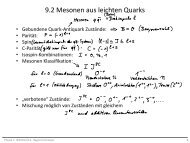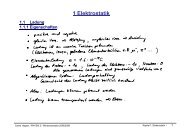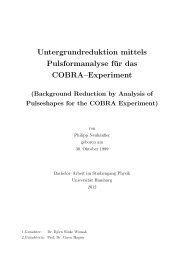Setup of a Drift Tube Muon Tracker and Calibration of Muon ...
Setup of a Drift Tube Muon Tracker and Calibration of Muon ...
Setup of a Drift Tube Muon Tracker and Calibration of Muon ...
Create successful ePaper yourself
Turn your PDF publications into a flip-book with our unique Google optimized e-Paper software.
0.80.70.6Solar Neutrino Survival ProbabilityMSW-LMA PredictionMSW-LMA-NSI PredictionMaVaN PredictionSNO DataGa/Cl Data Before Borexino0.80.70.6Solar Neutrino Survival ProbabilityMSW-LMA PredictionMSW-LMA-NSI PredictionMaVaN PredictionSNO DataBorexino DataGa Data after BorexinoP ee0.5P ee0.50.40.40.30.30.2Before Borexino E [MeV]1 100.2After Borexino E [MeV]1 10Figure 4.7: Energy dependent survival probability <strong>of</strong> solar neutrinos for differentmatter effect mechanisms compared with solar oscillation data before <strong>and</strong> after theBorexino 7 Be measurements. Figures taken form [44]. The Borexino data stronglysupports the LMA solution <strong>of</strong> the MSW effect.less than 3.3% to the solar luminosity.Matter Enhanced OscillationsThe survival probability <strong>of</strong> mono-energetic solar 7 Be neutrinos can be used to testthe different models <strong>of</strong> matter enhanced oscillations. Fig. 4.7 shows the predictions <strong>of</strong>the MSW-LMA, MSW-LMA-NSI, <strong>and</strong> MaVaN models presented in Section 2.3.3 foroscillations <strong>of</strong> solar neutrinos. Solar neutrino oscillation experiments before Borexinocould not distinguish between the different models. Results from the 7 Be neutrinomeasurements, however now strongly support the LMA solution <strong>of</strong> the MSW effect.Day-Night AsymmetryThe 7 Be neutrino spectrum has been also investigated for a possible day-night asymmetry.Depending on the model, mass effects in Earth could lead to a regeneration<strong>of</strong> solar neutrinos oscillated into ν µ or ν τ back into ν e . The neutrino rate wouldthen depend also on the latitude <strong>of</strong> the detector as well as the time <strong>of</strong> the day. Atnight, the Sun would appear brighter in the neutrino light. A preliminary analysisis presented in [73]. Measurements from 422.12 days are presented in Fig. 4.8. Thedata splits up into 212.87 days <strong>and</strong> 209.25 nights. The day night asymmetry A dn isdefined asA dn = c n − c dc n + c d,where c n <strong>and</strong> c d are the number <strong>of</strong> counts during night <strong>and</strong> day respectively. Anaverage value <strong>of</strong> A dn = 0.011 ± 0.014 is found, showing no significant day nightasymmetry <strong>and</strong> thus confirming the expectation <strong>of</strong> the LMA-MSW scenario <strong>and</strong>excluding the alternate oscillation scenario based on the mass varying model (cf.Section 2.3.3)63





